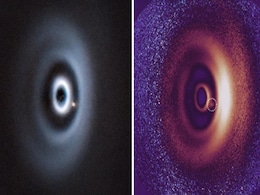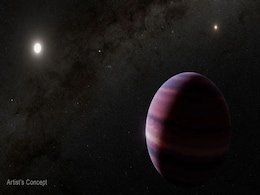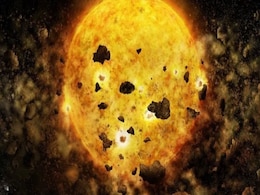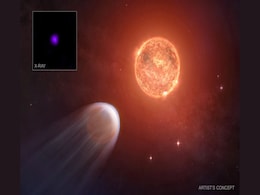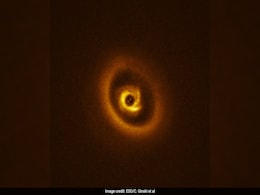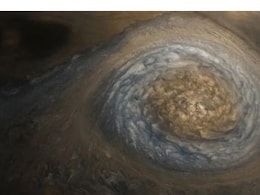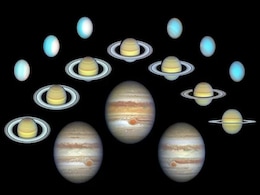Gas Giant Planet
- All
- News
-

James Webb Space Telescope Spots an Exoplanet Losing Its Atmosphere in a Huge Helium Stream
- Thursday December 4, 2025
Astronomers using NASA’s James Webb Space Telescope have observed a massive helium cloud escaping from the super-puff exoplanet WASP-107b, marking the first direct detection of such atmospheric loss. Webb’s infrared data reveal an enormous exosphere nearly ten times the planet’s radius, with helium streaming both ahead of and behind the plane...
-
 www.gadgets360.com
www.gadgets360.com
-

Astronomers Capture First-Ever Image Of A Baby Planet Forming In Real Time
- Tuesday October 7, 2025
- Science |
Astronomers have made a groundbreaking discovery by directly observing a young protoplanet, WISPIT 2b, embedded in a ring-shaped gap in a disk around a young star.
-
 www.ndtv.com
www.ndtv.com
-

A Planet Is Being Born: Astronomers Capture Rare Cosmic Snapshot
- Saturday August 30, 2025
Astronomers have captured a groundbreaking sight: WISPIT 2b, a baby gas giant planet forming within a dusty, multi-ring protoplanetary disk around a young Sun-like star 430 light-years away. Infrared images from the Very Large Telescope show the planet carving a dark path in the rings as it feeds on gas and dust. This rare discovery provides the fi...
-
 www.gadgets360.com
www.gadgets360.com
-

James Webb Telescope Detects Potential Gas Giant Exoplanet Just 4 Light-Years Away
- Friday August 8, 2025
Astronomers using JWST have spotted a possible gas giant orbiting Alpha Centauri A, only 4 light-years away. If confirmed, it would be the closest exoplanet to a Sun-like star ever imaged. The discovery could challenge current models of planetary formation in binary systems and open new opportunities for studying nearby worlds.
-
 www.gadgets360.com
www.gadgets360.com
-

Doomed Exoplanet TOI-2109b Spirals Toward Its Star with Three Possible Fates
- Monday July 28, 2025
The gas giant TOI-2109b, over five times Jupiter’s mass, is spiraling closer to its star in a rare planetary death spiral. With a 16-hour orbit and blistering heat, the exoplanet could either plunge into its host star, be torn apart by tidal forces, or evolve into a rocky super-Earth through photoevaporation. NASA’s TESS and ESA’s Cheops data...
-
 www.gadgets360.com
www.gadgets360.com
-

Young Exoplanet Spotted Shedding Atmosphere Under Stellar Radiation
- Thursday July 17, 2025
NASA’s Chandra X-ray Observatory and Hubble Space Telescope have captured a dramatic cosmic event: a baby exoplanet, TOI 1227 b, is being stripped of its atmosphere by powerful X-rays from its host star. Only 8 million years old and orbiting a red dwarf, this Jupiter-sized planet is losing gas at a rate equal to Earth’s entire atmosphere every ...
-
 www.gadgets360.com
www.gadgets360.com
-

Did Something Hit Saturn? Astronomers Investigate Possible Impact Flash
- Wednesday July 9, 2025
- Science |
Unlike rocky planets where asteroid impacts leave visible craters, gas giants like Saturn have outer layers of hydrogen and helium that can absorb impacts without obvious traces.
-
 www.ndtv.com
www.ndtv.com
-

New Study Reveals How Jupiter’s Storms Hide Ammonia
- Thursday May 1, 2025
A new study reveals Jupiter’s monster storms create mushballs—giant hailstones made of ammonia and water. This discovery explains the puzzling absence of ammonia in the planet’s upper atmosphere and suggests similar processes might be happening on gas giants across the universe.
-
 www.gadgets360.com
www.gadgets360.com
-

Exoplanet WASP-121 b’s Atmosphere Features Iron Rains, Jet Streams, and More
- Thursday February 20, 2025
Astronomers have uncovered extreme weather patterns on WASP-121 b, a gas giant 900 light-years from Earth. The planet experiences iron rain, with metals vaporizing on its scorching dayside and condensing into liquid at night. Supersonic winds carry elements across its atmosphere, forming powerful jet streams. Using the Very Large Telescope, researc...
-
 www.gadgets360.com
www.gadgets360.com
-

Amateur Astronomer Discovers Unexpected Composition of Jupiter’s Clouds
- Saturday January 11, 2025
Recent observations by an amateur astronomer reveal that Jupiter’s clouds may not consist of ammonia ice as previously assumed. Using a technique called band-depth analysis, Steve Hill mapped ammonia concentrations in the planet’s atmosphere, finding reflective layers deeper than expected. These findings suggest the clouds may be composed of am...
-
 www.gadgets360.com
www.gadgets360.com
-

Ammonium Hydrosulfide Identified as Primary Component of Jupiter’s Clouds, Not Ammonia
- Wednesday January 8, 2025
Jupiter’s clouds, long believed to be made of ammonia ice, are now confirmed to consist primarily of ammonium hydrosulfide combined with photochemical materials. This groundbreaking discovery, achieved through collaboration between amateur and professional astronomers, has redefined our understanding of the planet's atmosphere. Using innovative m...
-
 www.gadgets360.com
www.gadgets360.com
-

Hubble Telescope Documents 10 Years of Dramatic Changes on Outer Planets
- Friday December 13, 2024
NASA’s Hubble Telescope has tracked atmospheric and seasonal changes on Jupiter, Saturn, Uranus, and Neptune over ten years. Key findings include shifts in Jupiter’s Great Red Spot, Saturn’s seasonal phenomena, Uranus’ polar brightness, and Neptune’s storm activity. These insights, part of NASA’s Outer Planet Atmospheres Legacy (OPAL) p...
-
 www.gadgets360.com
www.gadgets360.com
-

James Webb Space Telescope Spots an Exoplanet Losing Its Atmosphere in a Huge Helium Stream
- Thursday December 4, 2025
Astronomers using NASA’s James Webb Space Telescope have observed a massive helium cloud escaping from the super-puff exoplanet WASP-107b, marking the first direct detection of such atmospheric loss. Webb’s infrared data reveal an enormous exosphere nearly ten times the planet’s radius, with helium streaming both ahead of and behind the plane...
-
 www.gadgets360.com
www.gadgets360.com
-

Astronomers Capture First-Ever Image Of A Baby Planet Forming In Real Time
- Tuesday October 7, 2025
- Science |
Astronomers have made a groundbreaking discovery by directly observing a young protoplanet, WISPIT 2b, embedded in a ring-shaped gap in a disk around a young star.
-
 www.ndtv.com
www.ndtv.com
-

A Planet Is Being Born: Astronomers Capture Rare Cosmic Snapshot
- Saturday August 30, 2025
Astronomers have captured a groundbreaking sight: WISPIT 2b, a baby gas giant planet forming within a dusty, multi-ring protoplanetary disk around a young Sun-like star 430 light-years away. Infrared images from the Very Large Telescope show the planet carving a dark path in the rings as it feeds on gas and dust. This rare discovery provides the fi...
-
 www.gadgets360.com
www.gadgets360.com
-

James Webb Telescope Detects Potential Gas Giant Exoplanet Just 4 Light-Years Away
- Friday August 8, 2025
Astronomers using JWST have spotted a possible gas giant orbiting Alpha Centauri A, only 4 light-years away. If confirmed, it would be the closest exoplanet to a Sun-like star ever imaged. The discovery could challenge current models of planetary formation in binary systems and open new opportunities for studying nearby worlds.
-
 www.gadgets360.com
www.gadgets360.com
-

Doomed Exoplanet TOI-2109b Spirals Toward Its Star with Three Possible Fates
- Monday July 28, 2025
The gas giant TOI-2109b, over five times Jupiter’s mass, is spiraling closer to its star in a rare planetary death spiral. With a 16-hour orbit and blistering heat, the exoplanet could either plunge into its host star, be torn apart by tidal forces, or evolve into a rocky super-Earth through photoevaporation. NASA’s TESS and ESA’s Cheops data...
-
 www.gadgets360.com
www.gadgets360.com
-

Young Exoplanet Spotted Shedding Atmosphere Under Stellar Radiation
- Thursday July 17, 2025
NASA’s Chandra X-ray Observatory and Hubble Space Telescope have captured a dramatic cosmic event: a baby exoplanet, TOI 1227 b, is being stripped of its atmosphere by powerful X-rays from its host star. Only 8 million years old and orbiting a red dwarf, this Jupiter-sized planet is losing gas at a rate equal to Earth’s entire atmosphere every ...
-
 www.gadgets360.com
www.gadgets360.com
-

Did Something Hit Saturn? Astronomers Investigate Possible Impact Flash
- Wednesday July 9, 2025
- Science |
Unlike rocky planets where asteroid impacts leave visible craters, gas giants like Saturn have outer layers of hydrogen and helium that can absorb impacts without obvious traces.
-
 www.ndtv.com
www.ndtv.com
-

New Study Reveals How Jupiter’s Storms Hide Ammonia
- Thursday May 1, 2025
A new study reveals Jupiter’s monster storms create mushballs—giant hailstones made of ammonia and water. This discovery explains the puzzling absence of ammonia in the planet’s upper atmosphere and suggests similar processes might be happening on gas giants across the universe.
-
 www.gadgets360.com
www.gadgets360.com
-

Exoplanet WASP-121 b’s Atmosphere Features Iron Rains, Jet Streams, and More
- Thursday February 20, 2025
Astronomers have uncovered extreme weather patterns on WASP-121 b, a gas giant 900 light-years from Earth. The planet experiences iron rain, with metals vaporizing on its scorching dayside and condensing into liquid at night. Supersonic winds carry elements across its atmosphere, forming powerful jet streams. Using the Very Large Telescope, researc...
-
 www.gadgets360.com
www.gadgets360.com
-

Amateur Astronomer Discovers Unexpected Composition of Jupiter’s Clouds
- Saturday January 11, 2025
Recent observations by an amateur astronomer reveal that Jupiter’s clouds may not consist of ammonia ice as previously assumed. Using a technique called band-depth analysis, Steve Hill mapped ammonia concentrations in the planet’s atmosphere, finding reflective layers deeper than expected. These findings suggest the clouds may be composed of am...
-
 www.gadgets360.com
www.gadgets360.com
-

Ammonium Hydrosulfide Identified as Primary Component of Jupiter’s Clouds, Not Ammonia
- Wednesday January 8, 2025
Jupiter’s clouds, long believed to be made of ammonia ice, are now confirmed to consist primarily of ammonium hydrosulfide combined with photochemical materials. This groundbreaking discovery, achieved through collaboration between amateur and professional astronomers, has redefined our understanding of the planet's atmosphere. Using innovative m...
-
 www.gadgets360.com
www.gadgets360.com
-

Hubble Telescope Documents 10 Years of Dramatic Changes on Outer Planets
- Friday December 13, 2024
NASA’s Hubble Telescope has tracked atmospheric and seasonal changes on Jupiter, Saturn, Uranus, and Neptune over ten years. Key findings include shifts in Jupiter’s Great Red Spot, Saturn’s seasonal phenomena, Uranus’ polar brightness, and Neptune’s storm activity. These insights, part of NASA’s Outer Planet Atmospheres Legacy (OPAL) p...
-
 www.gadgets360.com
www.gadgets360.com



